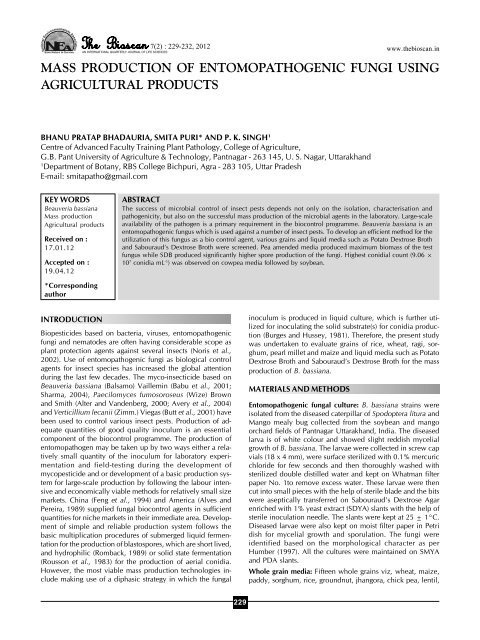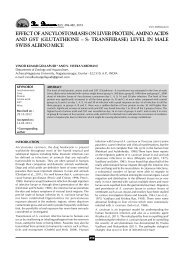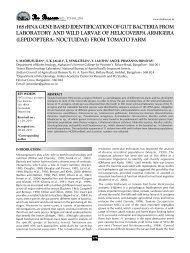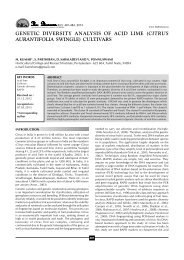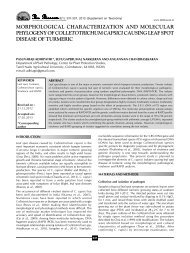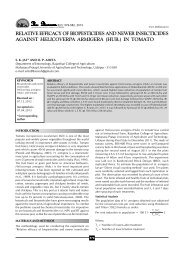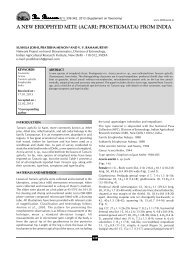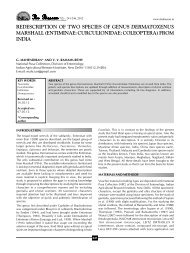fullpaper - THE BIOSCAN
fullpaper - THE BIOSCAN
fullpaper - THE BIOSCAN
Create successful ePaper yourself
Turn your PDF publications into a flip-book with our unique Google optimized e-Paper software.
NSave Nature to Survive<br />
7(2) : 229-232, 2012 www.thebioscan.in<br />
MASS PRODUCTION OF ENTOMOPATHOGENIC FUNGI USING<br />
AGRICULTURAL PRODUCTS<br />
BHANU PRATAP BHADAURIA, SMITA PURI* AND P. K. SINGH 1<br />
Centre of Advanced Faculty Training Plant Pathology, College of Agriculture,<br />
G.B. Pant University of Agriculture & Technology, Pantnagar - 263 145, U. S. Nagar, Uttarakhand<br />
1<br />
Department of Botany, RBS College Bichpuri, Agra - 283 105, Uttar Pradesh<br />
E-mail: smitapatho@gmail.com<br />
KEY WORDS<br />
Beauveria bassiana<br />
Mass production<br />
Agricultural products<br />
Received on :<br />
17.01.12<br />
Accepted on :<br />
19.04.12<br />
ABSTRACT<br />
The success of microbial control of insect pests depends not only on the isolation, characterisation and<br />
pathogenicity, but also on the successful mass production of the microbial agents in the laboratory. Large-scale<br />
availability of the pathogen is a primary requirement in the biocontrol programme. Beauveria bassiana is an<br />
entomopathogenic fungus which is used against a number of insect pests. To develop an efficient method for the<br />
utilization of this fungus as a bio control agent, various grains and liquid media such as Potato Dextrose Broth<br />
and Sabouraud’s Dextrose Broth were screened. Pea amended media produced maximum biomass of the test<br />
fungus while SDB produced significantly higher spore production of the fungi. Highest conidial count (9.06 ×<br />
10 7 conidia mL -1 ) was observed on cowpea media followed by soybean.<br />
*Corresponding<br />
author<br />
INTRODUCTION<br />
Biopesticides based on bacteria, viruses, entomopathogenic<br />
fungi and nematodes are often having considerable scope as<br />
plant protection agents against several insects (Noris et al.,<br />
2002). Use of entomopathogenic fungi as biological control<br />
agents for insect species has increased the global attention<br />
during the last few decades. The myco-insecticide based on<br />
Beauveria bassiana (Balsamo) Vaillemin (Babu et al., 2001;<br />
Sharma, 2004), Paecilomyces fumosoroseus (Wize) Brown<br />
and Smith (Alter and Vandenberg, 2000; Avery et al., 2004)<br />
and Verticillium lecanii (Zimm.) Viegas (Butt et al., 2001) have<br />
been used to control various insect pests. Production of adequate<br />
quantities of good quality inoculum is an essential<br />
component of the biocontrol programme. The production of<br />
entomopathogen may be taken up by two ways either a relatively<br />
small quantity of the inoculum for laboratory experimentation<br />
and field-testing during the development of<br />
mycopesticide and or development of a basic production system<br />
for large-scale production by following the labour intensive<br />
and economically viable methods for relatively small size<br />
markets. China (Feng et al., 1994) and America (Alves and<br />
Pereira, 1989) supplied fungal biocontrol agents in sufficient<br />
quantities for niche markets in their immediate area. Development<br />
of simple and reliable production system follows the<br />
basic multiplication procedures of submerged liquid fermentation<br />
for the production of blastospores, which are short lived,<br />
and hydrophilic (Romback, 1989) or solid state fermentation<br />
(Rousson et al., 1983) for the production of aerial conidia.<br />
However, the most viable mass production technologies include<br />
making use of a diphasic strategy in which the fungal<br />
inoculum is produced in liquid culture, which is further utilized<br />
for inoculating the solid substrate(s) for conidia production<br />
(Burges and Hussey, 1981). Therefore, the present study<br />
was undertaken to evaluate grains of rice, wheat, ragi, sorghum,<br />
pearl millet and maize and liquid media such as Potato<br />
Dextrose Broth and Sabouraud’s Dextrose Broth for the mass<br />
production of B. bassiana.<br />
MATERIALS AND METHODS<br />
Entomopathogenic fungal culture: B. bassiana strains were<br />
isolated from the diseased caterpillar of Spodoptera litura and<br />
Mango mealy bug collected from the soybean and mango<br />
orchard fields of Pantnagar Uttarakhand, India. The diseased<br />
larva is of white colour and showed slight reddish mycelial<br />
growth of B. bassiana. The larvae were collected in screw cap<br />
vials (18 x 4 mm), were surface sterilized with 0.1% mercuric<br />
chloride for few seconds and then thoroughly washed with<br />
sterilized double distilled water and kept on Whatman filter<br />
paper No. 1to remove excess water. These larvae were then<br />
cut into small pieces with the help of sterile blade and the bits<br />
were aseptically transferred on Sabouraud’s Dextrose Agar<br />
enriched with 1% yeast extract (SDYA) slants with the help of<br />
sterile inoculation needle. The slants were kept at 25 ± 1°C.<br />
Diseased larvae were also kept on moist filter paper in Petri<br />
dish for mycelial growth and sporulation. The fungi were<br />
identified based on the morphological character as per<br />
Humber (1997). All the cultures were maintained on SMYA<br />
and PDA slants.<br />
Whole grain media: Fifteen whole grains viz, wheat, maize,<br />
paddy, sorghum, rice, groundnut, jhangora, chick pea, lentil,<br />
229
BHANU PRATAP BHADAURIA et al.,<br />
pea, black gram, rajma, soybean, green gram, cow pea and<br />
pearl millet were used for estimating the sporution of B.<br />
bassiana, at 28ºC. 100g of each grain was washed and soaked<br />
in water overnight except rice which were soaked for 2 - 3h<br />
prior of starting the experiments. The excess water was drained<br />
by decanting and shade drying it for half an hour to further<br />
remove the excess moisture. The grains were packed separately<br />
in 500 mL conical flask, with cotton plug and auto calved at<br />
15 psi for 20 min. After cooling, 1 mL of the spore suspension<br />
of fungal pathogen was inoculated into each flask under<br />
laminar air flow chamber. They were incubated in BOD<br />
incubator at 28ºC for 15 days. Three replications were<br />
maintained for each grain. To avoid clumping, after 7 days of<br />
inoculation, the flasks were shaken vigorously to separate the<br />
grain and to break the mycelial mat. After 15 days of incubation,<br />
10g homogenous grain sample drawn from each replicate of<br />
uniformly sporulating flasks was transferred to 100 mL sterilized<br />
distilled water containing Tween 80 (0.05%) solution in 250<br />
mL conical flasks. The flasks were shaken in mechanical shaker<br />
for 10 min. The suspension was filtered through double layered<br />
muslin cloth. Counting of spore’s were made after the serial<br />
dilution of the suspension using double ruled Neubauer<br />
haemocytometer for determining the number of conidia in 1 g<br />
of the cereal grains.<br />
Liquid media: Potato Dextrose Broth and Sabouraud’s<br />
Dextrose Broth, were evaluated for the growth and sporulation<br />
of Beauveria bassiana fungi. 100 mL of each medium was<br />
poured in 250 mL capacity conical flasks and autoclaved at<br />
15 psi pressure for 30 min. Five flasks of each medium was<br />
inoculated with 1 mL of spore suspension of fungi separately<br />
and incubated at 28ºC for 15 days. The spore suspension<br />
was subjected to spore counting and it was carried out as<br />
described in the previous section.<br />
Statistical analysis: ANOVA was used to analyse the<br />
significance of temperature and media on sporulation of fungal<br />
pathogens using ‘STATISTICA’ computer package.<br />
RESULTS AND DISCUSSION<br />
Beauveria bassiana is an entomopathogenic fungus. The<br />
present experiments were conducted to find out morphological<br />
variation, growth patterns and suitable media for its mass<br />
production. Table 1 revealed that dry weight of Pantnagar<br />
isolate of B. bassiana varied from 0.0 g to 0.765g on different<br />
media. Growth of this isolate on liquid media indicated<br />
maximum dry matter production in pea broth followed by<br />
chickpea. Liquid media, SDB produced significantly higher<br />
spore production of test fungi. Biomass production of 0.69<br />
and 0.63 g was recorded in B. bassiana on SDB. Potato<br />
Dextrose Broth (PDB) also supported spore production of the<br />
fungus (Table 1). Dangar et al. (1999) also observed similar<br />
findings in Metarizhium anisepliae. They found that<br />
abundance of glucose and minerals in the coconut water may<br />
enhance the growth and spore production of fungi. Rice and<br />
wheat washed water also supported the growth and sporulation<br />
of test fungi. Patel et al. (1990) reported that the purified rice<br />
wash water gave the best spore count in M. anisepliae. No<br />
significant difference in dry matter production of the fungus<br />
was observed among solid media having wheat, paddy,<br />
sorghum, groundnut, lentil and black gram, separately.<br />
Table 1: Biomass production (g) and sporulation (x10 7 ) of Beauveria<br />
bassiana on various substrates<br />
S. No. Media Dry weight of Conidial count<br />
fungus (g) (10 7 mL -1 )<br />
1 Wheat 0.378 (0.936) 2.66 (1.76)<br />
2 Maize 0.238 (0.859) 2.33 (1.67)<br />
3 Paddy husk 0.383 (0.939) 3.33 (1.95)<br />
4 Sorghum 0.506 (1.003) 5.00 (2.34)<br />
5 Rice 0.555 (1.027) 7.60 (2.84)<br />
6 Groundnut 0.488 (0.994) 4.40 (2.21)<br />
7 Jhangora 0.000 (0.7071) 0.00 (0.70)<br />
8 Chickpea 0.701 (1.096) 6.40 (2.62)<br />
9 Lentil 0.629 (1.062) 7.60 (2.84)<br />
10 Pea 0.765 (1.124) 8.00 (2.91)<br />
11 Black gram 0.616 (1.056) 6.80 (2.70)<br />
12 Rajma 0.195 (0.833) 2.33 (1.67)<br />
13 Soybean 0.671 (1.082) 8.00 (2.91)<br />
14 Green gram 0.500 (0.999) 5.40 (2.42)<br />
15 Cowpea 0.652 (1.073) 9.06 (3.09)<br />
Liquid media<br />
16 SDB 0.696 (1.090) 6.53 (2.65)<br />
17 PDB 0.635 (1.060) 5.60 (2.47)<br />
CD at 5% 0.028 (0.014) 0.928 (0.211)<br />
* Parentheses values are square root transformed x + 0.5<br />
However, significant difference was observed in mycelia<br />
growth of fungus on SDB and PDB liquid media. Generally,<br />
higher dry matter production was observed on broth of pulses<br />
as compared to broths of cereals and oilseed. However, we<br />
widely used jhangora grains for the mass production of<br />
Trichoderma spp. as it is very cheap and easily available. In<br />
flasks having jhangora broth, due to the growth of undesireable<br />
fungi like Penicillium, Aspergillus, Mucor etc. no growth of<br />
B.bassiana was observed which indicate its non suitability for<br />
mass production of this fungus. Pilot studies using Jhangora<br />
grains will help to confirm these findings.<br />
Highest conidial count (9.06 × 10 7 conidia mL -1 ) was observed<br />
on cowpea media followed by soybean. Significant differences<br />
in conidial count were observed on maize, paddy, sorghum,<br />
rice and chickpea. Whereas, no significant difference was<br />
observed on the fungal growth among rice, lentil, pea and<br />
soybean added media. All the pulses along with wheat are<br />
known to have appreciable amounts of protein. Higher<br />
nitrogen has been shown to be necessary for mycelial growth<br />
of fungi (Riba and Glande, 1980; IM et al., 1988) which may<br />
be a reason for maximum production of biomass and conidia<br />
on Chickpea, pea, soybean etc. Most of these pulses and<br />
grains are part of human diet and their cultivation charges<br />
make them less economical for the mass multiplication of<br />
B.bassiana. Cheap culture medium is required in order to<br />
increase the cost-benefit ratio. Hence, several sources were<br />
tested for mass multiplication. Low cost sources of nutrients<br />
like millets such as sorghum, jhangora, and pearl millet were<br />
assessed for their utility in terms of conidial yield of the test<br />
fungus. Some of these grains are inexpensive, easily available<br />
and act as best nutritive media for the mass multiplication of<br />
many micro and macro organisms. Previously, Ibrahim and<br />
Low (1993) and Sharma et al. (2002) found rice as a suitable<br />
media for the mass culture of B. bassiana. This cereal was also<br />
used for the mass production of other deuteromycete fungi.<br />
Gopalakrishnan et al. (1999) reported that sorghum was the<br />
ideal cereal for the mass production of Paecilomyces farinosus,<br />
230
PRODUCTION OF ENTOMPATHOGENIC FUNGI<br />
it also supported satisfactory growth and sporulation of<br />
B.bassiana in our experiments also. In the case of Verticillium<br />
lecanii, sorghum was found to be the ideal cereal for mass<br />
production, which is in confirmation with the findings of<br />
Lakshmi et al. (2001). The ability of an entomopathogenic<br />
fungus to grow on different pests depends on the nutrients<br />
present on the insect body which is directly based on the<br />
plant they feed (Ambethagar et al., 1998). The present study<br />
also supported this fact in which among several naturally<br />
available substrates tested for mass multiplication of B.<br />
bassiana SDB and Pea seeds are most suitable for its growth<br />
and development. Moreover, B.bassiana has wide host range<br />
and it was isolated from pests of banana (Kaaya et al., 1991),<br />
rice (Puzari et al., 1997), cashew (Ambethagar, 1991, 1996,<br />
and 1997), beans (Landa, 1984), crucifers (Butt et al., 1994),<br />
chickpea and pigeonpea (Gopalkrishnan and Narayanan,<br />
1988) around the world. Previous workers have also<br />
successfully used agro-wastes such as crushed maize cobs,<br />
wheat bran, rice bran, bagasse and press mud singly and<br />
along with supplementation for mass multiplication of<br />
Metarhizium and Verticillium (Vimaladevi and Prasad, 1996).<br />
The use of different agricultural wastes is economical and<br />
also helps in their efficient utilization. For a successful<br />
integrated pest management programme, the agents like the<br />
entomopathogenic fungi should be amenable to easy and<br />
cheap mass multiplication. From this study it was clear that<br />
the test fungus is able to grow on a variety of cheap and easily<br />
available grains. These grains can be used for the mass<br />
multiplication of the fungus and it may increase its efficiency<br />
as a biocontrol agent which is also economic and easily<br />
available. Refined experiments using other easily available<br />
nutrient sources like corn steep liquor, rice and wheat straw,<br />
corn stalks and other agricultural wastes will probably provide<br />
more information on the utility of different agro wastes for<br />
production of entomopathogenic fungi.<br />
REFERENCES<br />
Alter, J. A. and Vandenberg, J. J. D. 2000. Factors that Influencing<br />
the Infectivity of Isolates of Paecilomyces fumosoroseus Agains<br />
Diamond Back Moth. J. Invertebr Pathol. 78: 31-36.<br />
Alves, S. B. and Pereira, R. M. 1989. Production of Metarhizium<br />
anisopliae and Beauveria bassiana. Ecosustania. 14: 188-192.<br />
Ambethgar, V. 1991. Biochemistry of epizootics of the fly fungus,<br />
Pandora delphacis (hort.) Humber in the rice brown plant hopper,<br />
Nilaparvata lugens (Stal), M.Sc.(Agri.) Thesis, Annamalai University,<br />
Tamil Nadu, India.<br />
Ambethgar, V. 1996. Biological control of brown plant hopper<br />
Nilaparvata lugens with entomogenous fungi. Madras Agri. J. 8: 203-<br />
204.<br />
Ambethgar, V. 1997. Record of white muscardius fungus, Beauveria<br />
bassiana (Bals.) Vuill. On rice leaf folder complex from Karaikol.<br />
Pondicherry Union Territory (India). J. Ento. Res. 21: 197-199.<br />
Ambethgar, V., Lakshmanam, V. and Dinakaran, D. 1998. Bio control<br />
agent for cashew borers. The Hindu, May 28, p.24.<br />
Avery, P. B., Faulla, J. and Simmands, M. S. J. 2004. Effect of Different<br />
Photoperiods on the Infectivity and Colonization of Paecilomyces<br />
fumosoroseus. J. Insect Sci. 4: 38.<br />
Babu, V., Murugan, S. and Thangaraja, P. 2001. Laboratory Studies<br />
on the Efficacy of Neem and the Entomopathogenic Fungus Beauveria<br />
bassiana on Spodoptera litura”. Entomology. 56: 56-63.<br />
Burges, A. D. and Hussey, N. W. 1981. Microbial Control of Insect<br />
Pests and Mite, Academic Press, London, pp. 161-167.<br />
Butt, T. M., Ibrahim, L., Ball, B. V. and Clark, S. J. 1994. Pathogenicity<br />
of the entomogenous fungi Metarhizium anisopliae and Beauveria<br />
bassiana against crucifer pests and the honeybee. Bio. Ser. Tech. 4:<br />
207-217.<br />
Butt, T. M., Jackson, C. W. and Murugan, W. 2001. Fungi as Biocontrol<br />
Agents,Progress,Problems and Potentials. CBBS Publshing Co, UK,<br />
pp. 240-242.<br />
Dangar, T. K., Geetha, L., Jayapal, S. D. and Pillai, G. B. 1999. Mass<br />
Production of the Entomopathogens Metarhizium anisopliae in<br />
Coconut Water. J. Plant. Crop. 19: 54-59.<br />
Feng, M. G., Paponsk, T. J. and Kbachachiurians, G. G. 1994.<br />
Production, Formulation and Application of the Entomopathogenic<br />
Fungus Beauveria bsssiana For Insect Control. Biocontrol Sci. Technol.<br />
4: 531-544.<br />
Gopalakrishnan, C., Anusuya, D. and Narayanan, K. 1999. In vitro<br />
Production of Conidia of Entomopathogenic Fungus Parcilomyces<br />
farinosus. Entomology. 24: 389-392.<br />
Gopalkrishnan, C. and Narayanan, K. 1988. Occurrence of two<br />
entomofungal pathogens, Metarhizium anisopliae(Metschinkoff)<br />
Sorokin var. minor Tulloch and Nomuraea rileyi on Heliothis armigera.<br />
Curr. Sci. 57: 867-868.<br />
Humber, R. A. 1997. Manual OJ Techniques in Insect Pathology<br />
Academic Pree, London pp. 153-155.<br />
Ibrahim, Y. B. and Low, W. 1993. Potential of Mass Production and<br />
Field Efficacy of Isolates of the Entomopathoghenic Fungi Beauveria<br />
bassiana and Paecilomyces fumosoroseus on Plutella xylostella. J.<br />
Invertebr. Pathol. 39: 222-232.<br />
Im, D. J., Lee, M. H., Aguda, R. M. and Rombach, M. C. 1988. Effect<br />
of nutrients on pH on the growth and sporulation of four<br />
entomogenous hypomycetes fungi (Deuteromycotina). Korean J.<br />
Appl.Ento. 27: 41-46.<br />
Kaaya, G. P., Kokwaro, E. D. and Murithi, J. 1991. Mortalities in<br />
adult Glossina morsitans experimentally infected with the<br />
entomogenous fungi, Beauveria bassiana and Metarhizium anisopliae.<br />
Dis. Inno. 3: 55-60.<br />
Lakshmi, S. M., Alagammai, P. L. and Jayaraj, K. 2001. Studies on<br />
Mass Culturing of the Entomopathogen Whitehalo Fungus Verticillium<br />
lecanii on Three Grain Media and Its Inefficacy on Helicoverpa<br />
armigera, In Igbachimuthu S, Sen S (Eds.) Microbials In Insect Pest<br />
Management, Oxford and IBH publishing Pvt Ltd, New Delhi, pp.<br />
23- 27.<br />
Landa, Z. 1984. Protection against glasshouse whitefly, Trialeurodicus<br />
vaporariorum in integrated protection programmes for glasshouse<br />
chambers. Sbor. Ur. Zahor. 11: 215-218.<br />
Noris, R. F., Chen, E. P. S. and Kogn, M. 2002. Concepts in integrated<br />
Pest Management. Premise Hall of India Private Limited, New Delhi.<br />
Patel, K. C., Yadaw, D. V., Dube, H. C. and Patel, R. J. 1990.<br />
Laboratory and Mass Production Studies With Metarhizium anisopliae.<br />
Annu. Biol. 6: 135-138.<br />
Puzari, K. C., Sharma, D. K. and Saranka, L. K. 1997. Media for Mass<br />
Production of Beauveria bassiana. J. Biol. Contr. 11: 96-100.<br />
Riba, G. and Glande, A. 1980. Development of a nutritive medium<br />
for deep culture of the entomopathogenic fungus, Nomuraea rileyi.<br />
Entomophaga. 25: 317-322.<br />
Romback, M.C. 1989. Production of Beauveria bassinaa Conidia in<br />
Submerged Culture. Entomophaga. 5: 45-52.<br />
Rousson, S., Rainbautt, M. and Lonsane, B. K. 1983. Zymotics a<br />
Large Scale Fermenter Design and Evaluation, Appl. Biochem.<br />
Biotechnol. 42: 161-167.<br />
231
BHANU PRATAP BHADAURIA et al.,<br />
Sharma, K. 2004. Bionatural Mangement of Pests in Organic Farming.<br />
Agrobios Newsl. 2: 296-325.<br />
Sharma, S. P., Gupta, R. B. L. and Yadava, C. P. S. 2002. Selection of<br />
a Suitable Medium For Mass Multipication of Entomofungal pathogens.<br />
Indian J. Entomol. 14: 255-261.<br />
Vimala Devi, P. S. and Prasad, Y. G. 1996. Compatibility of oils and<br />
antifeedants of plant origin with the entomopathogenic fungus<br />
Nomuraea rileyi. J. Invertebr Pathol. 68: 91-93.<br />
232


